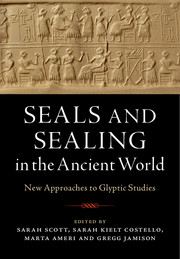 Seals and Sealing in the Ancient World
Seals and Sealing in the Ancient World Book contents
- Seals and Sealing in the Ancient World
- Seals and Sealing in the Ancient World
- Copyright page
- Contents
- Notes on Contributors
- Illustrations
- Plates
- Tables
- Acknowledgments
- Preface
- Abbreviations
- Chapter One Introduction: Small Windows, Wide Views
- Part I The Ancient Near East and Cyprus
- Part II South Asia and the Gulf Region
- Part III Egypt
- Part IV Aegean
- Chapter Eighteen Introductory Remarks, Aegean
- Chapter Nineteen Aegean Bronze Age Seal Stones and Finger Rings: Chronology and Functions
- Chapter Twenty An Aegean Seal in Greek Hands? Thoughts on the Perception of Aegean Seals in the Iron Age
- Chapter Twenty One Cryptic Glyptic: Multivalency in Minoan Glyptic Imagery
- Chapter Twenty Two The Magic and the Mundane: The Function of “Talismanic-Class” Stones in Minoan Crete
- References
- Endnotes
- Index
Chapter Twenty Two - The Magic and the Mundane: The Function of “Talismanic-Class” Stones in Minoan Crete
from Part IV - Aegean
Published online by Cambridge University Press: 24 April 2018
- Seals and Sealing in the Ancient World
- Seals and Sealing in the Ancient World
- Copyright page
- Contents
- Notes on Contributors
- Illustrations
- Plates
- Tables
- Acknowledgments
- Preface
- Abbreviations
- Chapter One Introduction: Small Windows, Wide Views
- Part I The Ancient Near East and Cyprus
- Part II South Asia and the Gulf Region
- Part III Egypt
- Part IV Aegean
- Chapter Eighteen Introductory Remarks, Aegean
- Chapter Nineteen Aegean Bronze Age Seal Stones and Finger Rings: Chronology and Functions
- Chapter Twenty An Aegean Seal in Greek Hands? Thoughts on the Perception of Aegean Seals in the Iron Age
- Chapter Twenty One Cryptic Glyptic: Multivalency in Minoan Glyptic Imagery
- Chapter Twenty Two The Magic and the Mundane: The Function of “Talismanic-Class” Stones in Minoan Crete
- References
- Endnotes
- Index
Summary
The so-called Talismanic class is a distinctive group of Minoan incised beads that were manufactured during the Neopalatial period on Crete. Although their form matches that of seal stones, there has been a certain reluctance to believe that they were actually used sphragistically. For most types of incised beads from the Near East and Aegean we have impressions on clay that confirm their use in stamping and securing. However, for the numerous Talismanic-class stones we have few impressions preserved. Their style is also strikingly abstract in appearance in a time and place where artistic styles tended toward naturalism. Therefore, it has been proposed that Talismanic stones were magical amulets or imitation seals. Beyond basic facts about their materials, typology, and techniques, very little has been proposed recently in terms of their socio-historical context. However, by tying together evidence from the manufacturing process, the contexts in which they were produced, and the uses of seals in the ancient world, we can compare what we know of Talismanic-class stones to the wider cultural context of the Mediterranean Bronze Age. As a result, we can start to see a clearer picture of how the Talismanic-class stones were used and by whom.
- Type
- Chapter
- Information
- Seals and Sealing in the Ancient WorldCase Studies from the Near East, Egypt, the Aegean, and South Asia, pp. 387 - 400Publisher: Cambridge University PressPrint publication year: 2018
